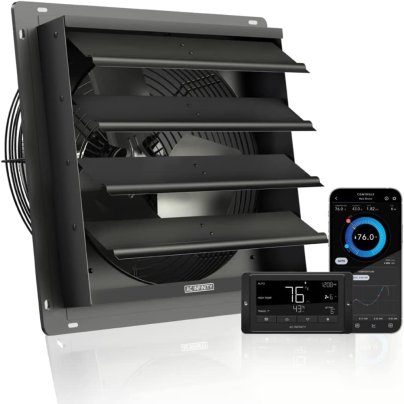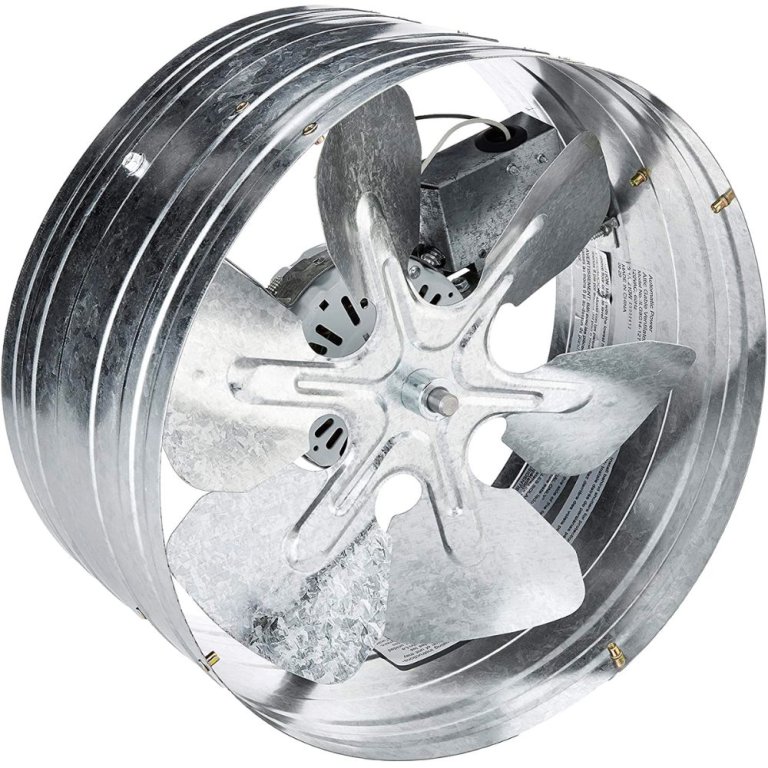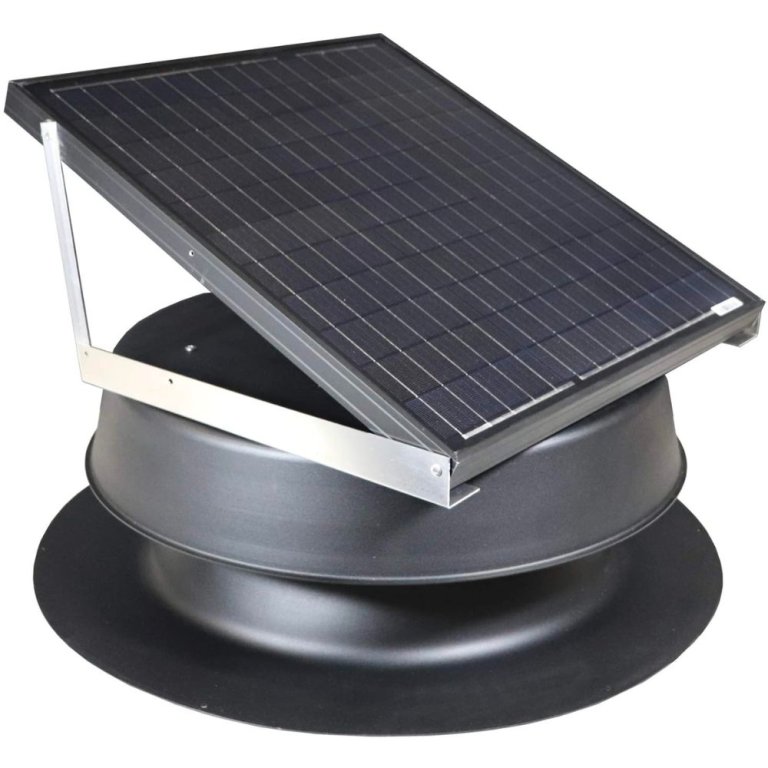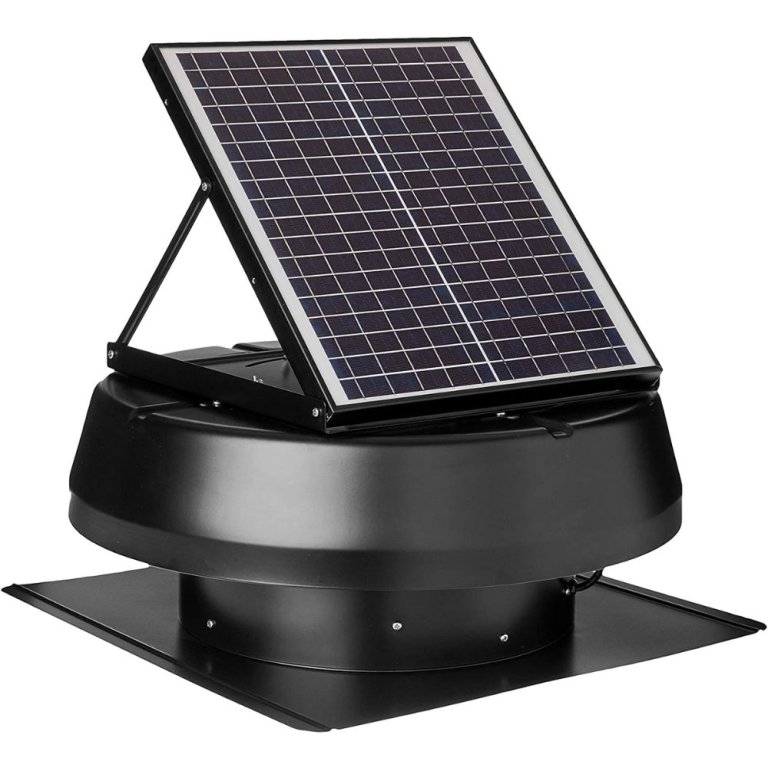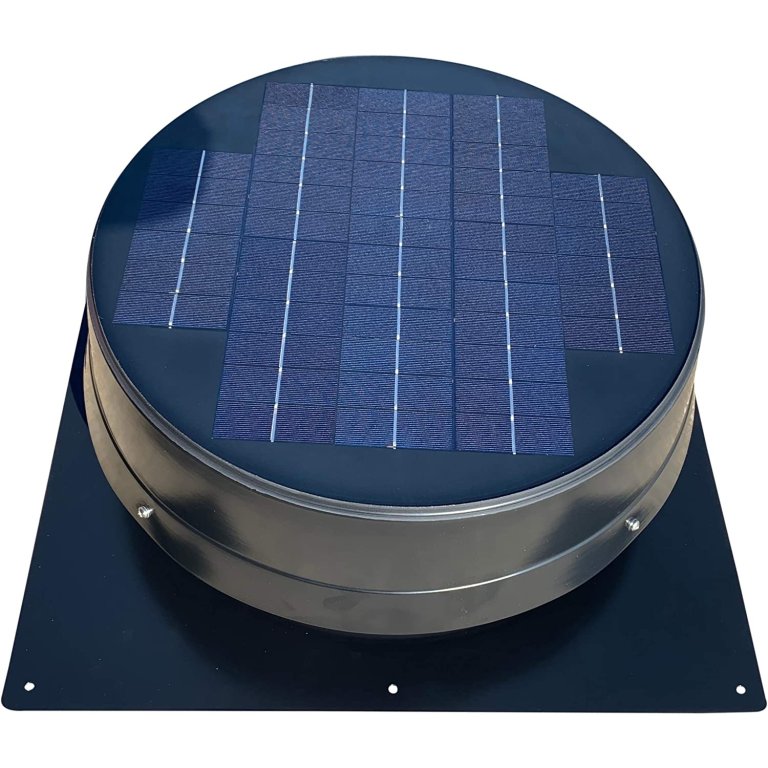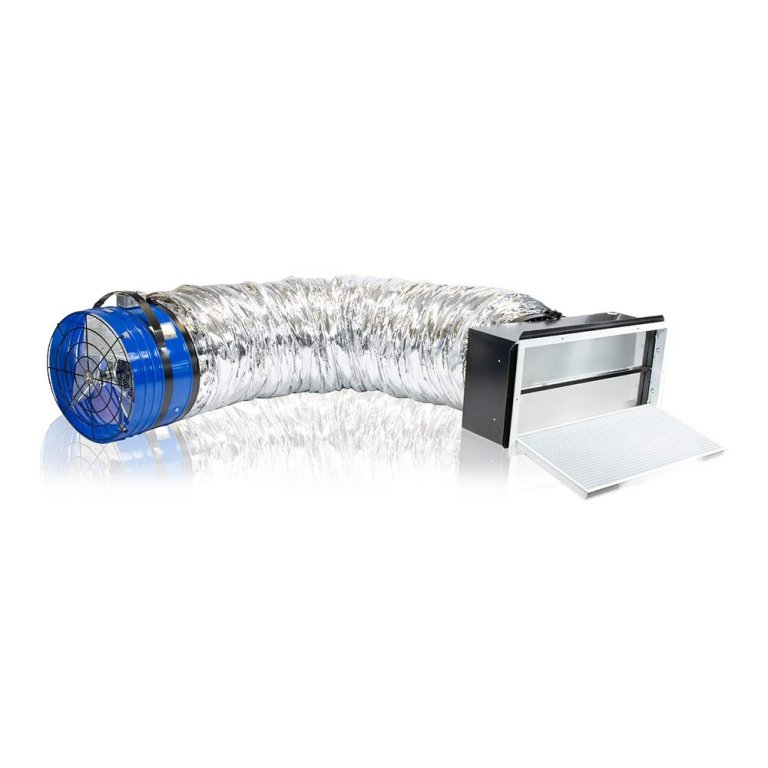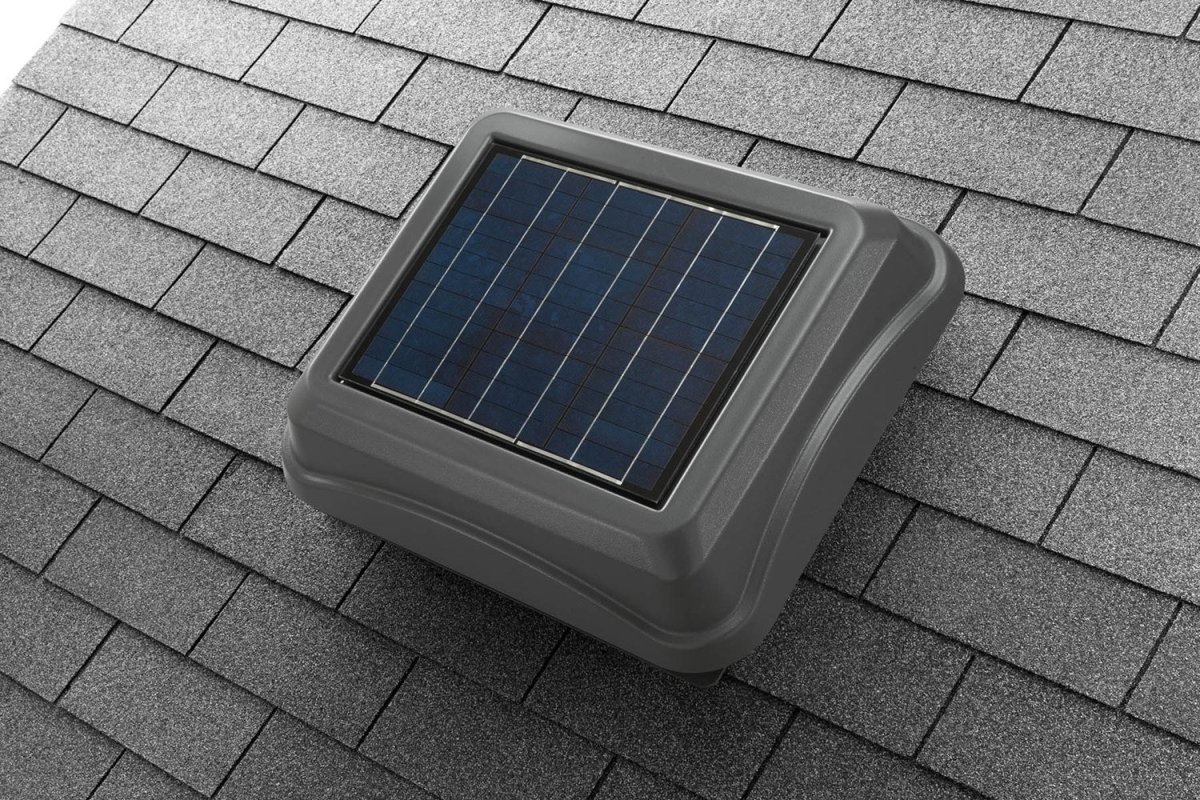
We may earn revenue from the products available on this page and participate in affiliate programs. Learn More ›
Attic fans are a smart complement to attic insulation because they help manage the heat from direct sun radiating onto roofs and into attic spaces. These useful appliances push hot air out while also pulling fresh, cool air in, reducing the conditions that could otherwise lead to moisture buildup and mold growth.
But with so many types available, including roof-mounted, gable-mounted, solar-powered, and whole-house options, it may not be as easy to choose the right model as you think. Some attic fans prioritize energy efficiency, while others focus on airflow or smart features. After researching dozens of popular picks and reaching out to a heating and cooling expert, we chose the Airlift T14 from AC Infinity as our favorite for its durable construction, digital thermostat, and Bluetooth-enabled functionality. Read on to learn about all our recommendations as well as our breakdown of which features matter most when shopping for one of the best attic fans for your home.
- BEST OVERALL: AC Infinity Airlift T14 Shutter Exhaust Fan
↓ Jump to Review - BEST BANG FOR THE BUCK: iLiving ILG8G14-12T Gable-Mount Attic Ventilator Fan
↓ Jump to Review - UPGRADE PICK: Natural Light 48-Watt Solar Attic Fan
↓ Jump to Review - BEST QUIET: QuietCool QC CL-3100 Advanced Whole-House Fan
↓ Jump to Review - BEST SOLAR-POWERED: iLiving ILG8SF301A Hybrid Smart Solar Roof Attic Fan
↓ Jump to Review - BEST ROOF-MOUNT: Remington Solar 20-Watt Roof-Mount Solar Attic Fan
↓ Jump to Review - BEST WHOLE-HOUSE: QuietCool QC CL-4700 Advanced Whole-House Fan
↓ Jump to Review
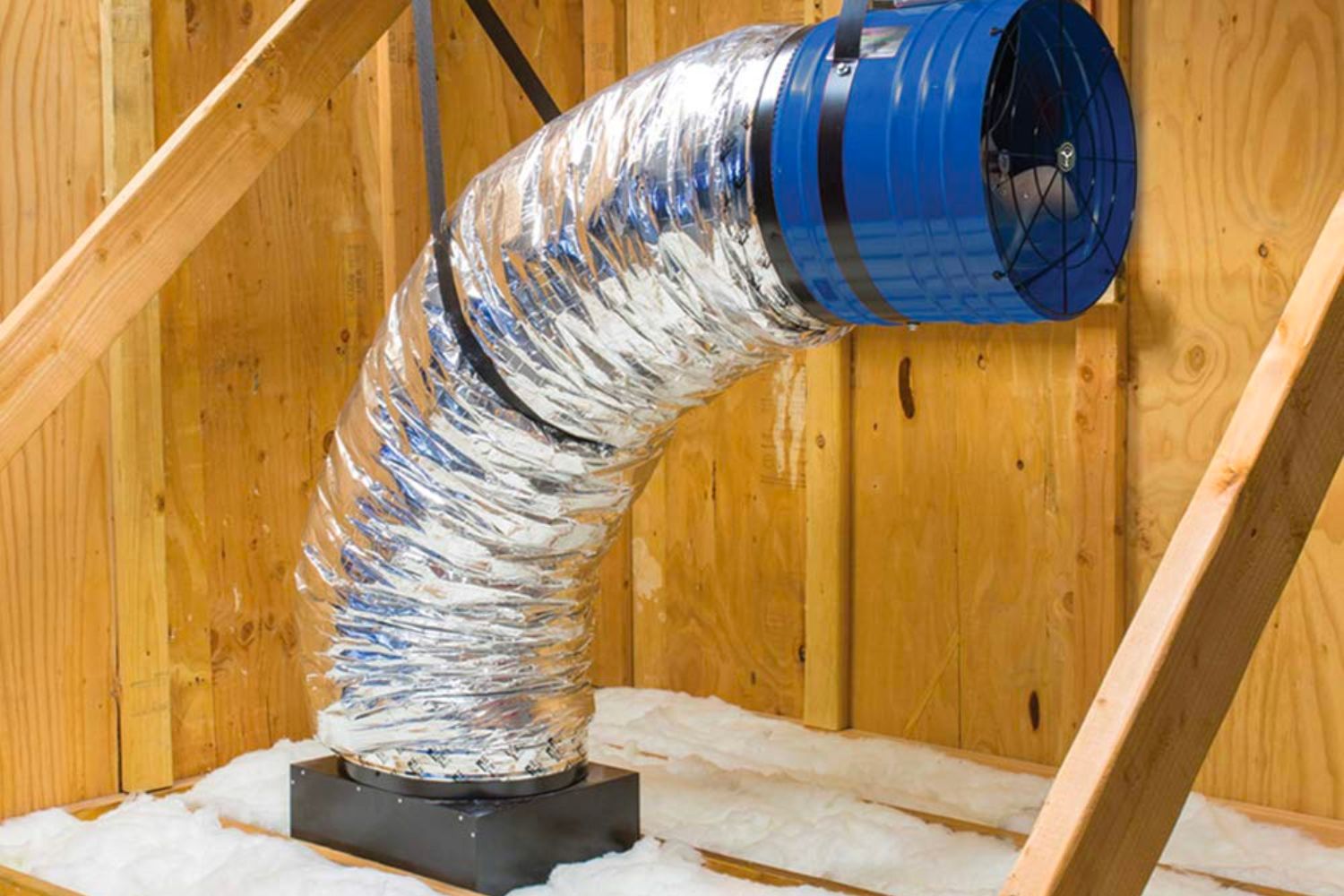
Attic Fans Comparison
| Product | Material | Air Volume (CFM) | Noise Level |
|---|---|---|---|
| AC Infinity Airlift T14 Shutter Exhaust Fan | Steel and aluminum | 1,513 | Moderate |
| iLiving ILG8G14-12T Gable-Mount Attic Ventilator Fan | Galvanized steel | 1,220 | Low |
| Natural Light 48-Watt Solar Attic Fan | Aluminum | 1,881 | Not listed |
| QuietCool QC CL-3100 Advanced Whole-House Fan | Galvanized steel | 3,009 | Low |
| iLiving ILG8SF301A Hybrid Smart Solar Roof Attic Fan | Aluminum | 1,750 | Moderate |
| Remington Solar 20-Watt Roof-Mount Solar Attic Fan | Powder-coated steel and stainless steel | 1,280 | Not listed |
| QuietCool QC CL-4700 Advanced Whole-House Fan | Galvanized steel | 4,415 | Low |
Our Top Picks
Below are our picks for the best attic fans for home ventilation. Each model excels in its category and will do an excellent job of reducing the issues excessive heat can cause in an attic.
Best Overall
Photo: AmazonWhat We Like
- Durable steel and aluminum construction
- Attic exhaust fan with thermostat and humidity control
- Bluetooth-enabled app for remote operation
- 28-foot wire makes installation easier
What We Don’t Like
- Slightly loud (68 decibels), even for an insulated attic space
Specs
- Material: Steel and aluminum
- Air volume (CFM): 1,513
- Noise level: Moderate
Homeowners looking for a through-the-wall gable-style attic fan with all the bells and whistles should check out the AC Infinity Airlift T14. This high-tech attic ventilation fan features steel and aluminum construction, ensuring it can hold up to the rigors of attic ventilation. It produces up to 1,513 CFM, making it suitable for medium-sized attics and even slightly larger spaces.
The Airlift T14 attic wall-mounted exhaust fan has some high-tech features as well. It has a thermostat with humidity control, timers, alarms, speed adjustments, and more—all programmable from an LCD digital control panel. We love that the entire system is also controllable from a Bluetooth-enabled app, and you can even link another attic fan to the control panel if you want more ventilation. It’s not solar, so it does require a power outlet, but the included cords measure 28 feet from the outlet to the controller to the attic exhaust fan. The only potential downside to this pick is that it produces 68 decibels of sound, which might be slightly loud for a finished attic space.
Get the AC Infinity attic fan at Amazon or Walmart.
Best Bang For The Buck
iLiving ILG8G14-12T Gable-Mount Attic Ventilator Fan
Buy at Amazon Buy at Lowe's Buy at Tractor Supply Co.What We Like
- Sturdy build is made to last years
- Covers 1,600 square feet (plenty for most attic spaces)
- Built-in programmable thermostat
What We Don’t Like
- Needs to be hardwired
- Outside vent cover/louvers sold separately
Specs
- Material: Galvanized steel
- Air volume (CFM): 1,220
- Noise level: Low
For folks with access to their attic’s gables, iLiving’s gable-mount attic fan is a great option for moving air without cutting a hole in the roof, as it installs through the wall and pairs with a vent cover (sold separately) to keep out pests and weather. This model is housed in sturdy galvanized steel, has a 3.1-amp motor, and is rated to ventilate up to 1,600 square feet of space. It also has a built-in thermostat for automatic activation and shutoff based on the air temperature. For the value-minded shopper, it offers an impressive amount of airflow and a long list of features at a competitive price.
There are a couple of drawbacks we need to point out, though. First, this gable-mount attic fan does not come with an outside vent cover or louvers, so you’ll need to purchase those separately. Second, it requires hardwiring, which will increase the attic fan’s installation cost for those without solid electrical skills.
Get the iLiving ILG8G14-12T attic fan at Amazon, Lowe’s, Tractor Supply Co., The Home Depot, or Wayfair.
Upgrade Pick
Natural Light 48-Watt Solar Attic Fan
Buy at AmazonWhat We Like
- Built-in 48-watt solar panel
- 2,825 square feet of coverage
- Adjustable angle to make the best use of sunlight
What We Don’t Like
- Thermostat and fire-safety switch are sold separately
Specs
- Material: Aluminum
- Air volume (CFM): 1,881
- Noise level: Not listed
If you’re looking to boost attic ventilation without increasing your energy bill, the Natural Light 48-watt solar attic fan is a solid choice. While it costs more than the other models on this list, it has some serious chops in terms of performance. Designed for easy installation on a shingle roof, it doesn’t require any wiring or electricity. Instead, it uses a 48-watt solar panel to draw energy from the sun and move up to 1,881 cubic feet of air—an impressive feat for an attic fan that runs on solar power.
Though the airflow this solar attic fan provides is astounding, it will run at full speed anytime the sun is out. For that reason, it may be worth purchasing a separate thermostat to prevent unnecessary wear and tear so the unit lasts longer.
Get the Natural Light attic fan at Amazon.
Best Quiet
Photo: AmazonWhat We Like
- Insulated to minimize noise
- Damper box helps protects from outside conditions
- Installs easily between ceiling joists
What We Don’t Like
- Insulated doors not included
Specs
- Material: Galvanized steel
- Air volume (CFM): 3,009
- Noise level: Low
The QuietCool CL-3100 eliminates one of the most well-known inconveniences of older whole-house fans. Instead of a loud, clunky setup, this model uses an acoustically insulated duct to keep noise to a minimum while still delivering serious airflow—3,009 CFM, to be exact—plenty to pull fresh air through an average-size home.The installation process for the QuietCool ceiling attic fan is also comparatively easy. The ceiling-mounted duct box secures to joists, while the motor sits at the far end of the duct, tucked away to reduce noise in the living space. If vented into a large attic space, you may not even notice that this fan is running.
The downside of this pick is that it doesn’t include insulated doors to seal it off when not in use, which means warm air may creep into your attic. It does have a gravity damper that helps reduce airflow when the fan is off, but adding an insulated vent cover will help keep air where you want it.
Get the QuietCool CL-3100 attic fan at Amazon, The Home Depot, or QuietCool.
Best Solar-Powered
iLiving ILG8SF301A Hybrid Smart Solar Roof Attic Fan
Buy at Amazon Buy at The Home Depot Buy at iLivingWhat We Like
- Adjustable angles to fully harness solar power
- IP68 waterproof brushless motor
- Smart thermostat for increased efficiency
What We Don’t Like
- Doesn’t come with a 120-volt adapter or screen guard
Specs
- Material: Aluminum
- Air volume (CFM): 1,750
- Noise level: Moderate
iLiving has a solid track record when it comes to developing quality ventilation products, and this solar-powered attic fan is one of the brand’s top models. It features an adjustable solar panel that generates enough power to move an impressive 1,750 cubic feet of air per minute—more than enough for the average attic space and four times the power of a typical air conditioner.
But this pick offers more than power. This solar-powered model also includes several additional features that help it stand out from the crowd. Unlike many solar models that run nonstop whenever the sun is shining, this one comes with a built-in adjustable thermostat that gives users control and increases the life of the unit. You can also purchase a separate 120-volt adapter that allows this solar-powered roof attic ventilator to run at night, which is especially useful in hot climates where attic temperatures stay high after sundown.
Get the iLiving ILG8SF301A attic fan at Amazon, The Home Depot, or iLiving.
Best Roof-Mount
Photo: AmazonWhat We Like
- Seamless shroud and flashing prevent potential leaks
- Durable powder-coated and stainless steel
- Thermostatic attic fan with humidity control
What We Don’t Like
- Users cannot adjust the thermostat’s preset range
Specs
- Material: Powder-coated steel, stainless steel
- Air volume (CFM): 1,280
- Noise level: Not listed
Folks aiming to vent their attics through the roof should consider the Remington Solar 20-watt roof ventilation fan. This model installs atop a shingled roof, and the flashing and shroud are seamless, ensuring there won’t be any leaks. It features durable powder-coated steel construction and stainless steel parts to help it last for years.
This solar attic fan has built-in photovoltaic solar cells that power it during the day. It also has a built-in thermostat with humidity control that activates it at 80 degrees Fahrenheit and 75 percent humidity and shuts it off below 65 degrees Fahrenheit or 55 percent humidity. Unfortunately, you can’t adjust the thermostat on this roof-mount attic fan, but at least you don’t have to turn it off and on manually.
Get the Remington Solar attic fan at Amazon or Remington Solar.
Best Quiet
Photo: AmazonWhat We Like
- Installs easily at the end of the ductwork
- Produces more airflow than all other models on this list
- Comes with insulated doors
What We Don’t Like
- Not suitable for sealed/non-vented attics
Specs
- Material: Galvanized steel
- Air volume (CFM): 4,415
- Noise level: Low
When it comes to quiet, effective whole-house fan ventilation, the QuietCool QC CL-4700 attic fan has plenty to offer. This model has a fan at the end of an insulated, self-contained duct system, which helps reduce sound and noise vibration inside the home. This allows it to quietly pull warm air out and bring cool air in at a noise level of just 50 decibels.
With a powerful output of 4,415 CFM, the CL-4700 is capable of ventilating homes up to 2,207 square feet. It also features a split-capacitor motor that improves energy efficiency and a damper system that helps maintain conditions when the fan isn’t running. Just keep in mind that it does require ventilation (like ridge vents, gable vents, or soffit vents) to operate effectively, so it’s not suitable for airtight attics.
Get the QuiteCool CL-4700 attic fan at Amazon, Lowe’s, The Home Depot, or QuietCool.
Jump to Our Top Picks

How We Chose the Best Attic Fans
To select the attic vent fan models for this list, we considered a variety of factors to ensure each option offered excellent performance, durability, and value. We looked at fan size and how easy each pick would be to install and compared options with different power sources, including electric and solar fans. We aimed to include units with timers or thermostats as well as those with wireless functionality.
Construction materials were also important. Most of the fans we selected are made from galvanized steel or aluminum, and many of the roof-mounted models include flanges to help prevent leaks. Airflow also played a big part in choosing picks for our list. To ensure we offered options for attics and homes of different sizes, we selected fans with a range of 1,220 to 4,415 CFM. We also took noise levels into account, favoring models that operate quietly so they won’t disrupt the rest of the living space.
What to Consider When Choosing an Attic Fan
When choosing among the best attic fans, it’s smart to start by looking at their capabilities and material construction. Then, consider ease of installation, noise, safety, and additional features.
Types of Attic Fans
In addition to simple box fans and tower fans, different attic fan types can help control the temperature of a home.
Whole-House Fans
Whole-house fans are installed into the ceiling of the highest point in the finished space—typically an upstairs hallway. When running, they pull heat and moisture from inside the house and force it into the attic space. They’re ideal for homeowners who like to open their windows at night, as the cool nighttime air replaces the hot air built up during the day.
The issue with a whole-house fan is that hot air needs somewhere to go. If the attic isn’t well-ventilated, humid air will build up and can cause mold to grow. Therefore, whole-house fans are best suited for homeowners with spacious, well-vented attics.
Attic Venting Fans
Attic vents serve a different function: They remove the hot and moist air from the attic and leave the space below the attic floor alone. These fans circulate the air within the attic, pulling fresh, cool air from the vents (like the ones in a soffit) and pushing hot air outside.
Attic fans can be useful year-round. In the summer, they can drastically reduce the temperature in the attic, helping to lengthen the life of the roofing shingles and sheathing. In colder months, they can help prevent ice-damn buildup and damage by equalizing the temperature between the attic and the outside. This prevents snow from melting on a roof and freezing when it hits the cold gutter.
For attic fan installation, it’s important to consider how well the attic is sealed off from the rest of the home. If an attic door or hatch is particularly drafty, turning the fan on will pull air-conditioned or heated air through the gaps, heating or cooling the neighborhood instead of the home.
Material
An attic fan must be built from material sturdy enough to survive the excessive heat that can build up in an attic. Cheaper fans with plastic components may begin to fail over time under these conditions. In the winter, plastic can become very brittle, making the fan blades likely to snap with normal use.
Models with metal bodies (aluminum or steel) will be far more durable in fluctuating temperatures and against moisture.
Ease of Use
Attic ventilation is useless if it’s too much of a hassle to turn on or off. Many whole-house models now come with remote controls, which allow users to turn the fan on from the floor below and customize its settings with the touch of a button. Other models come with a programmable thermostat or can be wired to one, which turns the fan on when the attic reaches a set temperature.
Safety
One very important aspect to consider when choosing an attic fan is safety, particularly if you’ll be installing it near an attic furnace. Attic fans can create enough draft to blow out a pilot light on a furnace, which will cause the furnace to output gas into the attic. While the fan is still running, it should be able to force the gas outside, but once it shuts off, gas can fill the attic and home, posing a danger to unsuspecting residents.
Whole-house and attic fans can also pull carbon monoxide back into the home through a damaged flue. Be sure that the flues are in good operating condition and that the furnace, oven, fireplace, and other appliances that use fuel are ventilating properly.
Venting Requirements
Understanding venting requirements for attic fans is important for a few reasons. If the fan requires more ventilation than an attic has, it will pull air from inside the conditioned space, negating the energy efficiency it was installed to create. On the other hand, if there’s too much ventilation, the fan won’t be efficient for removing accumulating hot air.
If a whole-house fan doesn’t have the proper ventilation, it won’t work very well either. It’ll fill the attic with hot air, stopping it from pulling more air into the space through open windows.
Adjustable Thermostat
Attic fans are similar to air conditioners in that they have adjustable thermostats that allow you to set a dial and forget about them. When the temperature within the attic reaches a set point, the fan will turn on and start venting the heated air, cooling the attic space.
Likewise, attic fans with thermostats will automatically shut off when the temperature drops back below the set temperature. They’re easy to use and help save money by not running the fan when it doesn’t need to be on.
Air Volume (CFM) and Square Footage
The higher the CFM, the more airflow a fan can produce. Choose a fan that matches a home or attic’s size for optimal performance. Too high of a CFM, and you’ll spend more money running the fan than you should. Too low of a CFM, and the fan will be spinning its wheels with little positive impact on the home.
If the fan you’re looking at doesn’t have stated CFM ratings emblazoned on the packaging, it should list a compatible amount of square footage. This is most likely if you’re looking at a whole-house fan.
Noise Level
Ah, noise—the bane of fan owners since the early days of the attic fan. Thankfully, these large fans now sound much more like quiet plug-in fans. Today’s highly efficient models tend to run much quieter than previous iterations, keeping the house cool in relative silence.
If an older fan is installed in the home, switching to a newer whole-house fan will provide a noticeable change in noise output. Newer models have smaller fans, create less turbulence, and have more efficient motors than the massive house fans of old.
FAQs
Most attic fan manufacturers have excellent customer support teams, so if you have any questions about the specific models on this list, you might want to give the company a call. If you still have a few general questions about attic ventilation fans, here are some answers that might help.
An attic fan works by exchanging the hot air in your attic space for fresh air pulled through the vents. This will help prevent premature damage to the shingles or mold in moist, hot attics.
You install an attic fan through the roof and flashing under the shingles. Gable fans are installed at the very top of your gable-end walls and vented through the walls outside. Whole-house fans require cutting through the finished ceiling on the highest floor of your home and ventilating outside. While an experienced DIYer may be able to wire these fans, most will want to call an electrician who installs attic fans.
You can, but models with accessible fans are usually pretty affordable to replace entirely. If you do want to replace the motor, bring it to an electrical shop, and they should be able to match you up with a new one. If not, they may be able to rebuild the one you have.
According to Erika Friedrich, Operations Manager at A-TEMP Heating & Cooling, attic fans can absolutely help lower electric bills. “An attic fan reduces heat buildup in the attic and helps distribute it throughout your home. In the winter, this can help keep your home warm, and in the summer it helps your A/C system work more efficiently, therefore lowering your electric bills.”
For more helpful tips, see our guide on 11 savvy hacks to slash your electric bill.
“Both have their pros and cons and what works best for one home may not work well for another. A solar fan is great for areas with lots of sunshine; it’s energy-efficient and cost-effective over time since it runs for free using sunlight while an electric fan has stronger airflow and provides consistent performance, with or without sunlight,” Friedrich says.
While you can run an attic fan all night if you like, they are most effective during the day when the sun is out. For the most control over when your attic fan runs, look for a model with a built-in thermostat or remote functionality.
Yes, attic fans are a good idea, especially when paired with proper attic insulation. They help remove hot, humid air, which can increase your home’s comfort level and energy efficiency while also preventing moisture buildup.
“The best spot is usually near the roof ridge, on a south-facing side if possible, so it gets the most sun exposure throughout the day,” says A-Temp Heating and Cooling’s Erika Friedrich.
The life expectancy of an attic ventilation system typically ranges from 10 to 15 years, depending on the quality of the fan and how often it runs. To help your attic fan last longer, be sure to install and maintain it according to the manufacturer’s instructions.
